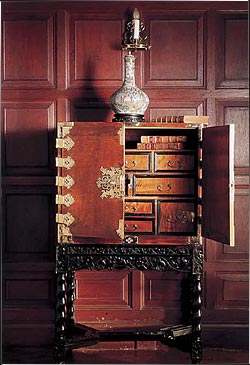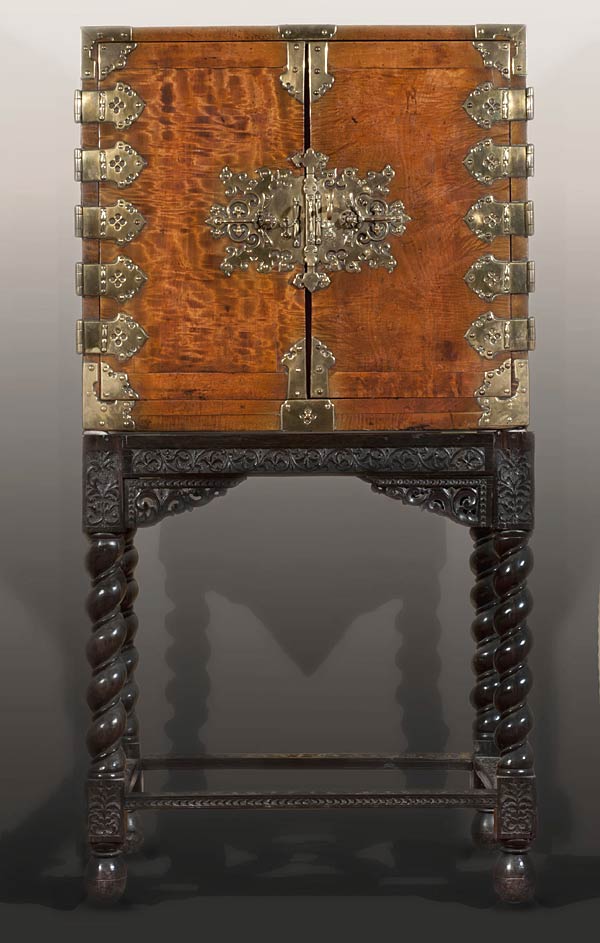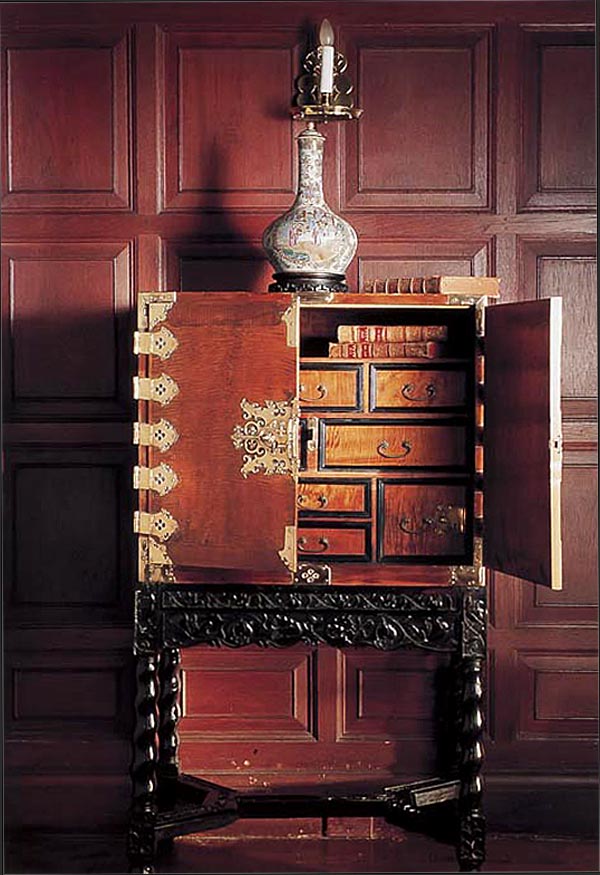Furniture
Collection IndexSatin Wood Cabinet
Batavia
Portable Satin Wood Cabinet with Brass Mounts set on an Ebony Stand
- Circa 1650 -1680
Overall dimensions: 138 x 70 x 48.5 cms
It was formerly in the possession of Gustaaf Willem van Imhoff, Governor General
of Dutch East Indies 1740-1750. Thence, by decent to a prominent Dutch family
in the Hague.
Around the third quarter of the 17th Century, there was a change in fashion
and taste and furniture with all-over carving came to be seen as old fashioned.
Carving became a subordinate feature or disappeared entirely. This cabinet
illustrates all these changes. It is made of red satin wood with brass hinges
and a brass lock plate.
The Shape of the mounts on the Indies portable cabinet agrees with, or is
derived from, those found on Japanese and Chinese lacquer cabinets. The stylised
lock plate on the centre of the cabinet has undulating edges and is attached
by brass studs. The sides of the cabinet have simple brass handles for lifting
it. The interior consists of ten drawers of varying sizes and a safe drawer
with a brass lock plate.
The original function of this cabinet is not entirely clear, but it may have
been intended to contain documents, or in view of the number of drawers to
a house collection of some kind. This type of cabinet is virtually indistinguishable
from those made in Holland. Usually the only difference is the use of tropical
hard wood. In this particular case the lock-plate also betrays an oriental
influence.
This Colonial cabinet is supported by an ebony stand. The legs of the stand
have double spiral twist and rectangular caps above and below, ending in a
bun. The rectangular top and the rails under the table top are adorned with
low-relief carving of flower and leaf tendrils on a hammered background. The
rectangular crossbars, attached to the bottom caps are also carved.
'Groote Shuur' Great Granary To Stately Home, page 69, Figure1 This elegant
17th century chest, fitted with small drawers, was made in Indonesia from
an Oriental hardwood. The stand is of a later date. Unrecognizable under layers
of paint, the chest was discovered by Rhodes’s agent, Arthur Collie,
in a Franshhek farmhouse
For related examples see:
1. Domestic Interiors at the Cape and in Batavia 1602-1795, Den Haag (2002)
Pl. 22 Gemeente museum Den Haag, Cat. No. OHO-1913-0002
Bequest by Miss A.C. Zegwaard
2. Furniture from Indonesia, Sri Lanka and India during the Dutch period
By Jan Veenendaal (1985)
Pl. 72 here described Cabinet of Teak with Brass Mounts, second half of the
17th century
Rijksmuseum, Amsterdam
3. Het Holllandsche Koloniale Barokmeubel
By Dr. V. I. Van de Wall, Antwerp 1939
No. 90 - Decorative Satinwood Cabinet on an Ebony Stand, second half of the
17th century, Prof. J. van Kan, Batavia 1934;
And No. 95 - Portable Root Wood Cabinet, second half of the 17th century,
Museum Het Princessehof in Leeuwarden.

Home


